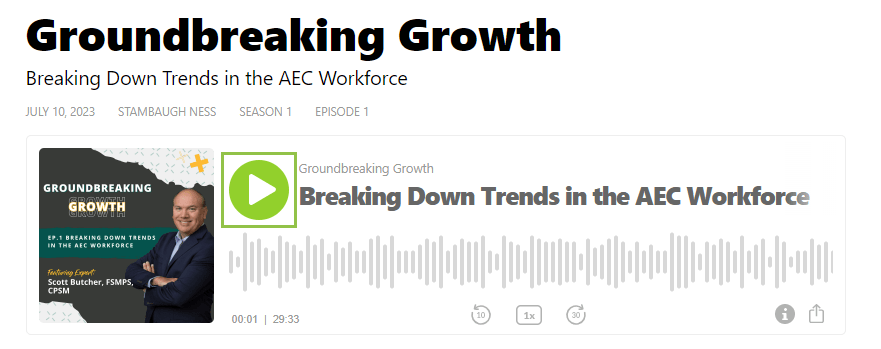Executive Call to Action: Where Will Tomorrow’s Workforce Come From?

Imagine that your firm has 200 open positions – about 20% of the size of your workforce – and you are projecting that you’ll need to fill another 150 positions in the coming year due to turnover. What I’ve just described isn’t a fictional scenario but rather a real-world situation facing an engineering firm. And it is not unique. Many AEC firms are in similar situations, asking, “Who will do the work?”
Unfortunately, a perfect storm of workforce issues is staring the design and construction industry in the face, and it will only worsen.
Here are some reasons why:
Growing Workforce Shortage
The ACEC Research Institute found that 56% of engineering firms turned down work in the last quarter because of a staff shortage, a 6% increase over the prior quarter. And Associated Builders and Contractors is projecting that an additional 546,000 workers will be needed this year on top of the normal pace of hiring. And the most recent data from the US Bureau of Labor Services identified 366,000 current job openings in construction.
Increasing Retirements
According to Forbes, 40% of the construction workforce in the United States will retire over the next decade. Factor in the current workforce shortage and the Baby Boomer exodus will exacerbate an already difficult situation, with talent and knowledge departing construction firms at an alarming rate.
Lack of Diversity
According to research from the Society of Women Engineers, only 16.1% of employees in architecture and engineering are female. A new report from the Equal Employment Opportunity Commission (EEOC) called out the construction industry for discrimination and lack of diversity. Women represent just 11% of the total construction workforce, while Blacks/African Americans represent just 7%. The AEC industry is not reflective of society.
Declining Employee Loyalty
Over the past decade, the median tenure for employees in architecture and engineering dropped a staggering 1.8 years, from 7.0 to 5.2 years. Construction tenure declined from 4.3 years in 2012 to 3.9 years in 2022.
Declining Birth Rate / Increasing Natural Change
The average number of children per adult female in the United States has declined from 3.7 in 1960 to about 1.6 in recent years. Furthermore, in 2022, deaths exceeded births in 24 states, and 18 states lost population. Only immigration is keeping population growth in the positive, and just barely.
Declining Productivity
Across all industries, value added per full-time worker, a primary metric for productivity, has steadily increased since the 1950s. However, the value added per worker in the construction sector has declined by 40% since 1970.
What Can AEC Firms Do?
Architects and engineers can leverage generative design and large language models like ChatGPT to boost productivity and offset many of the same workforce challenges currently facing construction firms.
Automation and robotics will increasingly enter the construction industry. Widespread use of additive manufacturing (3D printing), bricklaying and drywalling robots, automated rebar tying machines, robotic construction inspectors, autonomous construction vehicles, and construction drone swarms is coming, but this is too far off to solve the current staffing shortfall.
Two generations of students have been told to steer clear of jobs in construction, and the current workforce struggles are a testament to this. And yet, when you look at the future of construction, the jobs of tomorrow will be vastly different than the jobs of yesterday. Construction can be “sexy” and an attractive career to many as newer technologies come online and see general adoption.
As an industry, AEC needs to flip the script, and perhaps no place is this more critical than the issues related to diversity and the lack of an inclusive environment. Some firms have created DEI/JEDI committees to address these challenges, but as long as c-suites and board rooms are filled with predominantly white men, the promised changes will only be viewed as lip service. Still, many firms are creating aggressive goals for inclusivity, providing sensitivity and unconscious bias training to all staff, and building new relationships with diverse subcontractors and subconsultants. These firms will win the recruiting war in the future.
By leveraging technologies and elevating training and knowledge transfer in the coming years, productivity can be boosted. By changing the messaging and providing proactive education to younger students, the industry can be positioned as highly attractive and full of opportunity. By creating industry-wide inclusivity and promoting diversity, all genders, and races can find fulfilling careers.
But the AEC industry cannot change the declining birthrate, increasing rate of natural change, or massive pending retirements over the next decade. It’s better to focus on controlling what can be controlled: recruitment, retention, diversity and inclusion, training, and technology adoption to position your firm – and the industry – for the continued workforce challenges of the future.
Next Steps
Let’s embark on this journey together. Watch our on-demand webinar, AEC Executive Forum: Unlocking the Power of a High-Performance Workforce, where we explore strategies to help executives build a resilient workforce, foster sustainable growth, and gain a competitive advantage. Uniting our efforts, we can navigate the uncertainties ahead and forge a future for your firm to thrive.




